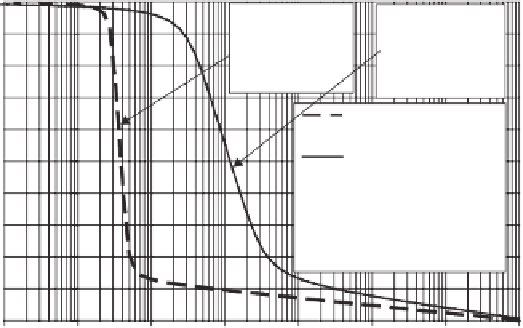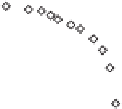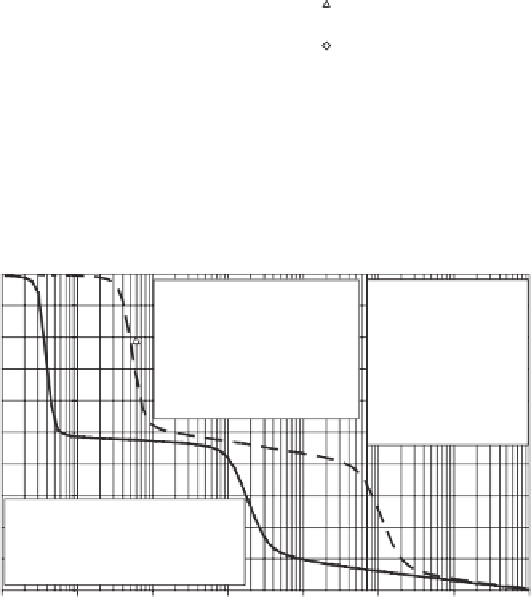Environmental Engineering Reference
In-Depth Information
100
y
aev
= 2.99 kPa
y
res
= 4.54 kPa
S
r
= 0.123
a
= 0.118
y
aev
= 36.0 kPa
y
res
= 267.8 kPa
S
r
= 0.111
a
= 0.150
90
80
70
Best-fit — unimodal
(two bending points)
Best-fit — unimodal
(two bending points)
Beaver Creek sand
(Sillers, 1997)
Patience Lake silt
(Bruch, 1993)
60
50
40
30
20
10
0
10
6
0.1
1
10
100
1000
10,000
100,000
Soil suction, kPa
Figure 5.66
Best-fit SWCC curves to experimental data for Patience Lake silt and Beaver Creek
sand (after Gitirana and Fredlund, 2004).
100
y
aev1
= 3.93 kPa
y
res1
= 7.27 kPa
S
r1
= 0.502
y
aev2
= 6559.0 kPa
S
b
= 0.417
y
res2
= 17538.0 kPa
S
r2
= 0.047
a
= 0.076
Brasilia collapsible clay,
3 meter (Camapum de
Carvalho et al., 2002)
Pelletized diatomaceous
earth (Burger and
Shackelford, 2001)
90
80
70
60
50
40
30
y
aev1
= 0.32 kPa
S
r1
= 0.478
y
res1
= 0.46 kPa
y
aev2
= 112.9 kPa
y
res2
= 291.5 kPa
a
= 0.080
20
S
aev
= 0.099
10
S
r1
= 0.475
0
10
6
0.1
1
10
100
1000
10,000
10,0000
Soil suction, kPa
Figure 5.67
Best-fit SWCC curves for experimental data on pelletized diatomaceous earth and
Brasilia collapsible clay (after Gitirana and Fredlund, 2004).
Figure 5.67 shows the best-fit curve, the fitting parameters,
and the experimental data for a pelletized diatomaceous earth
(Burger and Shackelford, 2001) and for residual, highly
collapsible clay from Brasilia (Camapum de Carvalho et al.,
2002). Close fits are observed for both materials.
developed in geotechnical engineering that test individual
soil specimens. Laboratory equipment for measuring the
SWCC can broadly be divided into equipment that provides
an applied matric suction and equipment that provides a
controlled total suction.
Matric suctions are applied to a soil specimen through use
of a high-air-entry disk (or a cellulose membrane). The max-
imum value of most high-air-entry disks is 1500 kPa. The
axis translation technique is used to develop a differential
air and water pressure without producing cavitations in the
water phase. Figure 5.68 shows a single-specimen pressure
plate device developed at the University of Saskatchewan,
Saskatoon, for applied suctions up to 500 kPa. An air pres-
sure can be applied to the specimen chamber through use of
an air pressure regulator. Water drains against atmospheric
pressure conditions and as a result a matric suction is applied
to the soil specimen (i.e.,
u
a
−
5.8 MEASUREMENT OF SWCC USING PRESSURE
PLATE DEVICES
Several types of test equipment and test procedures have
been used for measuring the SWCC. Much of the original
laboratory testing equipment for measuring the SWCC
was developed in the agricultural discipline. The early
measurement of the SWCC generally involved the use of
large pressure chambers that tested several soil specimens
at one time (Fredlund and Rahardjo, 1993a). A number of
smaller pressure-plate-type cells have more recently been
u
w
, where
u
a
=
pore-air
pressure and
u
w
=
pore-water pressure).








































Search WWH ::

Custom Search